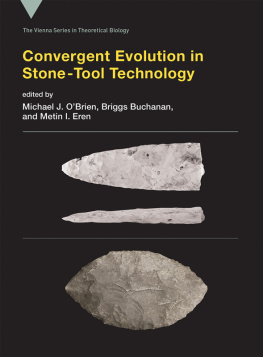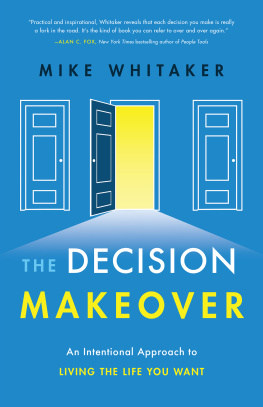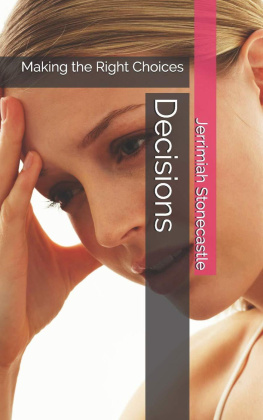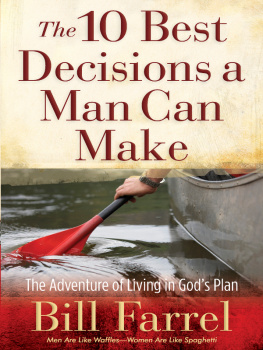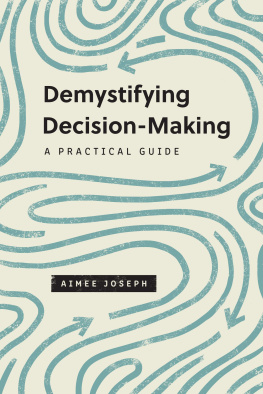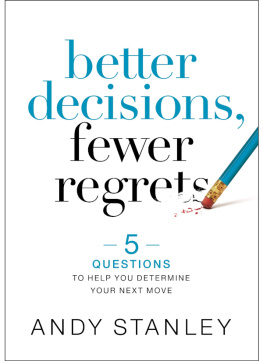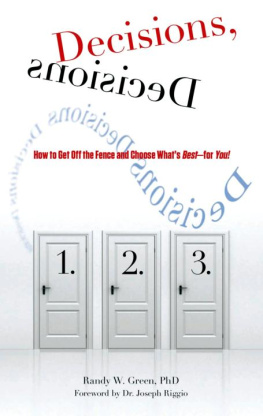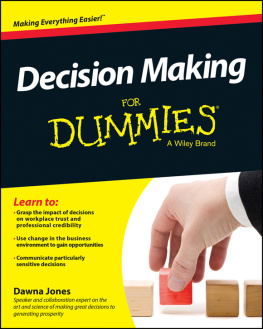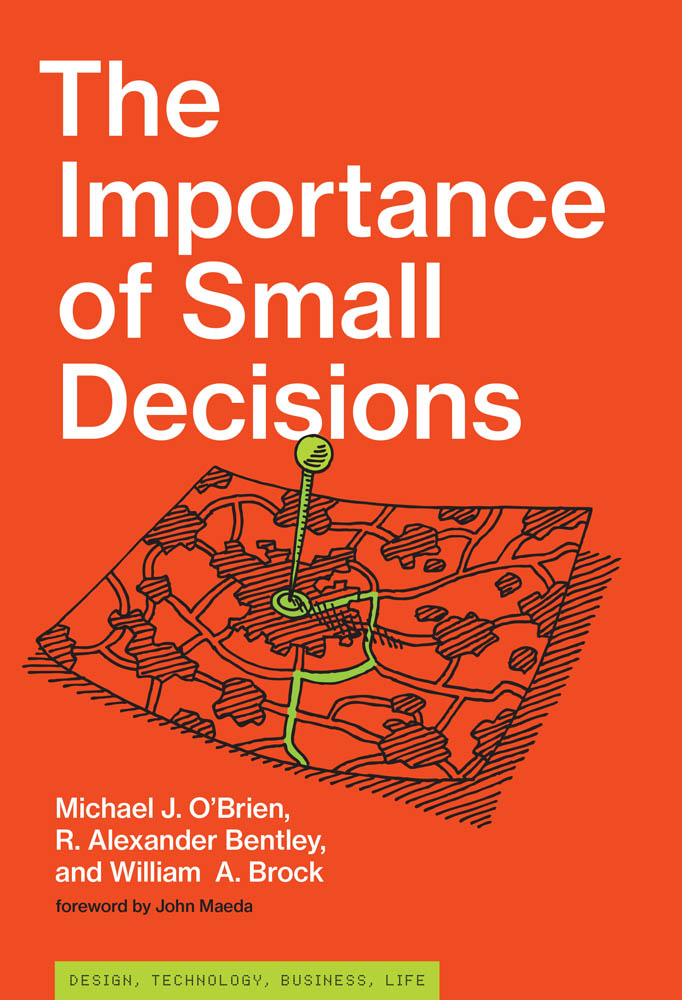
The Importance of Small Decisions
Simplicity: Design, Technology, Business, Life
John Maeda, Editor
The Laws of Simplicity, John Maeda, 2006
The Plenitude: Creativity, Innovation, and Making Stuff, Rich Gold, 2007
Simulation and Its Discontents, Sherry Turkle, 2009
Redesigning Leadership, John Maeda, 2011
Ill Have What Shes Having, Alex Bentley, Mark Earls, and Michael J. OBrien, 2011
The Storm of Creativity, Kyna Leski, 2015
The Acceleration of Cultural Change: From Ancestors to Algorithms, R. Alexander Bentley and Michael J. OBrien, 2017
Mismatch, Kat Holmes, 2018
The Importance of Small Decisions, Michael J. OBrien, R. Alexander Bentley, and William A. Brock, 2019
The Importance of Small Decisions
Michael J. OBrien, R. Alexander Bentley, and William A. Brock
FOREWORD BY JOHN MAEDA
The MIT Press
Cambridge, Massachusetts
London, England
2019 Massachusetts Institute of Technology
All rights reserved. No part of this book may be reproduced in any form by any electronic or mechanical means (including photocopying, recording, or information storage and retrieval) without permission in writing from the publisher.
Library of Congress Cataloging-in-Publication Data
Names: OBrien, Michael J., author. | Bentley, R. Alexander, 1970- author. | Brock, William A., author.
Title: The importance of small decisions / Michael J OBrien, R. Alexander Bentley, and William A. Brock ; foreword by John Maeda.
Description: Cambridge, MA : MIT Press, [2019] | Series: Simplicity: Design, technology, business, life | Includes bibliographical references and index.
Identifiers: LCCN 2018033820 | ISBN 9780262039741 (hardcover : alk. paper)
Subjects: LCSH: Decision making--Psychological aspects. | Interpersonal relations. | Social evolution.
Classification: LCC BF448 .O27 2019 | DDC 153.8/3--dc23 LC record available at https://lccn.loc.gov/2018033820
ISBN: 978-0-262-03974-1
Retail e-ISBN: 978-0-262-35254-3
Library e-ISBN: 978-0-262-35253-6
MITP e-ISBN: 978-0-262-35252-9
d_r0
Contents
John Maeda
Its easy to get comfortable with what you have achieved over time. So its useful to step back and consider how your state of comfort came to be. Was it earned through your sheer hard work? Or was it given to you based upon intrinsic advantages that you unknowingly enjoy?
The former narrative is what youre likely to prefer to tell yourself and to tell others as well. You persevered and overcame all odds. And your comfort is the result of a series of decisions that led you to where you are today as an independent-minded thinker. After all, why else would this slim volume with its unassuming title catch your attention?
In the parlance of OBrien, Bentley, and Brocks new map of social behavior, you are most assuredly in the west side of their map. You are the accumulation of what you have done on your own. And based upon the wisdom of your selecting this book, youre always seeking to make the best decisions from the latest available research.
But somethings stirring within your independent-mindedness. As you mature, youre becoming painfully aware of how the world is not about the choices that are made by pure logic alone. Instead, you come to realize that we more commonly make decisions based upon what others are doingwhich was the premise of an earlier book in the Simplicity series, Ill Have What Shes Having, written by two of the present authors, OBrien and Bentley, along with Mark Earls. Because the simplest choice you can make is to not choose at all, that is, to have someone else choose for you.
With each realization, you start to move around their map. And the deeper implications of our fully wired society start to come into focus. You begin to see that the many decisions that are being made around you are happening in pack-like behavior that, unwittingly, youve already implicitly joined based upon your behavior online.
However, the online world can also be rewarding if you can manage to leave your own bubbleespecially if youre lucky enough to come into contact with the concept of the Privilege Walk. Its an exercise in making visible certain advantages that some have and some dont.
With millions of views online, What Is Privilege? is a visually striking activity where everyone starts at the same line and then takes one step forward or backward based upon a series of questions. For example, participants are given instructions like If you were ever called names because of your race, class, or sexual orientation, take one step back, or If your parents both went to college, take one step forward.
The Privilege Walk is especially relevant to OBrien, Bentley, and Brocks map of social behavior because it reveals the embedded, and otherwise hidden, privileges in the more individualistic west part of their map. There are so many multigenerational advantages, or disadvantages, built into an individuals identity. This made me find another reading in their work, Ill have what others like me have had in the past.
My role as head of design and inclusion at the worlds largest fully distributed technology company has taken me to remote parts of the United States and Europe that psychologically embody all of the authors map quadrants. And Ive learned to bear less prejudice against any parts of the map that might be considered any less favorable than other parts. Can individuals ever break free from the ideas of the people around themselves? Or can individuals break free from the ideas embedded in the generations that came before themselves? Id like to believe so. How? By starting from a conscious understanding of where they stand on the social behavior map and then making the small, important series of decisions that can move them to wherever they want to bepreferably as far north as possible if theyre lucky enough to make it there. Good luck!
Most of us serve on at least one jury in our lifetime, and we would guess that most people actually look forward to the experience, perhaps influenced by any number of television shows that portray the courtroom as an exciting place, full of points and counterpoints, eloquent arguments, and lots of surprises. For those of us interested in decision-making and how it helps shape the human evolutionary landscape, courtrooms are like living laboratories. In fact, it would be difficult to find a better lab for cataloging the kinds of decisions that humans make, how they make them, the speed at which they make them, and the ramificationsboth short and long termof those decisions.
Perhaps no courtroom has ever given us a better lab than that of Los Angeles County Superior Court Judge Lance Ito between November 1994 and October 1995, when it was the (circus) stage for the trial of former NFL running back, announcer, actor, and pitchman O. J. Simpson, who was charged with murdering his former wife, Nicole Brown Simpson, and her friend Ron Goldman. They were found stabbed to death shortly after midnight on June 13, 1994, outside Nicoles condominium in the ritzy Brentwood section of Los Angeles. A few days later, the headline in the Los Angeles Times read, Simpson Held after Wild Chase: Hes Charged with Murder of Ex-Wife, Friend. After his arrest, decisions began to pile up. If youre Simpson, how do you decide whom to pick for your defense team? If youre district attorney Gil Garcetti, you have the same decision: which prosecutors do you pick to handle the case? Next decision: where in Los Angeles County to file the case. Garcetti had two choices: downtown Los Angeles or Santa Monica, which is adjacent to Brentwood. The choice of venue came down to where Garcetti thought he would have the best chance of winning the case. He decided on downtown Los Angeles, which in retrospect was a terrible decision because it meant that instead of a pool of affluent jurors who were Simpsons peers, Garcetti was putting his case into the hands of a vastly different jury pool.
Next page

